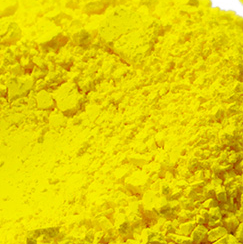| "Descrizione" by Ark90 (12432 pt) | 2023-Mar-23 09:37 |
Review Consensus: 10 Rating: 10 Number of users: 1
| Evaluation | N. Experts | Evaluation | N. Experts |
|---|---|---|---|
| 1 | 6 | ||
| 2 | 7 | ||
| 3 | 8 | ||
| 4 | 9 | ||
| 5 | 10 |
Quinoline is a chemical compound, derived from quinophthalone, a dye used in a variety of industries:
- Food
- Cosmetics. Nail polishes, cold soaps, liquid detergents.
- Pharmaceuticals. Tablets
- Textile. Fabrics
- Plastic
- etc
It is also used to add color to non-food producing animal feed at a maximum dose of 500 mg/kg of feed.
Labeled with the number E104 in the list of European food color additives and internationally known as CI 47005.
Safety
Regulatory data on the genotoxicity and/or mutagenicity of this compound are still controversial. This study finds that, even with in vitro testing, this dye could cause harmful effects in humans if it is metabolized or absorbed through the skin (1).

Typical optimum characteristics of the commercial colour Chinoline Yellow
| Colour Index n | 47005 |
| Food colour n. | Yellow 13 |
| F.D. & C. No. | Yellow 10 |
| Volatile matter (chloride and sulfate) Max | 30% |
| Solubility in water at 20°C | 120g/l |
| Combined ether extract. Max | 0.20% |
| Insoluble in water. Max | 0.20% |
| Class | Xanthene |
| Light stability | 4 |
| Stability at 100°C | 4 |
| Alkali stability | 4 |
| Subsidiary dyes. Max | 1.50% |
| Intermediate dyes. Max | 0.50% |
| Lead | <10ppm |
| Arsenic | <3ppm |
| Mercury | <1ppm |
| Heavy Metals | <20ppm |
 |  |
 |  |
- Molecular Formula : C18H9NNa2O8S2
- Molecular Weight : 477.369 g/mol
- CAS : 100208-62-6 8004-92-0
- EC Number 616-849-0
- UNII 0QYP77F82G
- InChI=1S/C18H11NO8S2.2Na/c20-17-11-3-1-2-4-12(11)18(21)15(17)13-6-5-9-7-10(28(22,23)24)8-14(16(9)19-13)29(25,26)27;;/h1-8,15H,(H,22,23,24)(H,25,26,27);;/q;2*+1/p-2
- InChl Key FZUOVNMHEAPVBW-UHFFFAOYSA-L
- SMILES C1=CC=C2C(=C1)C(=O)C(C2=O)C3=NC4=C(C=C(C=C4C=C3)S(=O)(=O)[O-])S(=O)(=O)[O-].[Na+].[Na+]
- IUPAC disodium;2-(1,3-dioxoinden-2-yl)quinoline-6,8-disulfonate
- DSSTox Substance ID DTXSID0041721 DTXSID70873122
- NACRES NA.47
Synonyms :
- CI 47005
- E104
- Acid Yellow 3
- Yellow 13
- Yellow 10
- Lemon Yellow ZN 3
- Quinoline Yellow S
- Quinoline yellow WS
- Sodium 2-(1,3-dioxo-2,3-dihydro-1H-inden-2-yl)quinoline-6,8-disulfonate
- 2-(2-Quinolyl)-1,3-indandione disulfonic acid disodium salt
- dipotassium 2-(1,3-dioxo-2H-inden-2-yl)quinoline-6,8-disulfonate
- disodium 2-(1,3-dioxo-2H-inden-2-yl)quinoline-6,8-disulfonate
- 2-(1,3-Dioxoindan-2-yl)quinoline-6,8-bis(sulfonic acid sodium) salt
- disodium 2-(1,3-dioxo-2,3-dihydro-1h-inden-2-yl)-6,8-quinolinedisulfonate
- disodium 2-(1,3-dioxo-2,3-dihydro-1H-inden-2-yl)quinoline-6,8-disulfonate
References______________________________________________________________
(1) Chequer FM, Venâncio Vde P, de Souza Prado MR, Campos da Silva e Cunha Junior LR, Lizier TM, Zanoni MV, Rodríguez Burbano R, Bianchi ML, Antunes LM. The cosmetic dye quinoline yellow causes DNA damage in vitro. Mutat Res Genet Toxicol Environ Mutagen. 2015 Jan 1;777:54-61. doi: 10.1016/j.mrgentox.2014.11.003.
Macioszek VK, Kononowicz AK. The evaluation of the genotoxicity of two commonly used food colors: Quinoline Yellow (E 104) and Brilliant Black BN (E 151). Cell Mol Biol Lett. 2004;9(1):107-22.
| Evaluate |

